|
Rule #
|
Aspect(s)
|
Indication
|
|
280a
|

|
Clear to Next Interlocking
|
Trains with inoperative cab signals, automatic train stop or speed control must proceed on fixed signal indication, (and cab signal indication, if operable) not exceeding 79 MPH.
Trains with inoperative cab signals must approach the next home signal prepared to stop, unless Approach Normal (Rule 280b) is displayed on a distant signal prior to the home signal.
|
|
280b
|

|
Approach Normal
|
Trains without operative cab signals must proceed on fixed signal indication not exceeding 79 MPH.
|
|
281
|
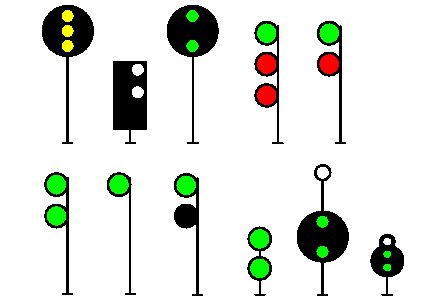
|
Clear
|
Proceed not exceeding Normal Speed.
|
|
281a
|
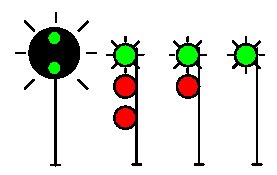
|
Cab Speed
|
Proceed in accordance with cab signal indication. Reduce speed to not exceeding 60 MPH if Cab Speed cab signal is displayed without a signal speed, or if cab signals are not operative.
|
|
281b
|
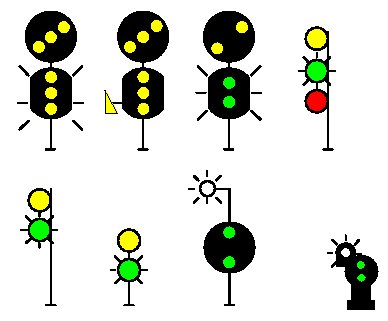
|
Approach Limited
|
Proceed approaching the next signal at Limited Speed.
|
|
281c
|
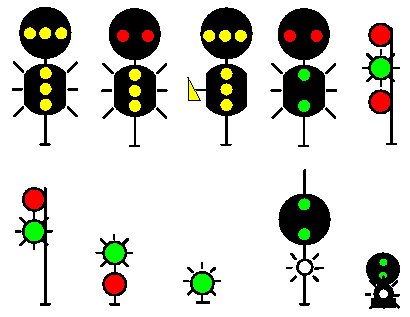
|
Limited Clear
|
Proceed at Limited Speed until entire train clears all interlocking or spring switches, then proceed at Normal Speed.
|
|
282
|

|
Approach Medium
|
Proceed approaching the next signal at Medium Speed.
|
|
282a
|

|
Advance Approach
|
Proceed prepared to stop at the second signal. Trains exceeding Limited Speed must begin reduction to Limited Speed as soon as engine passes the Advance Approach signal.
|
|
283
|
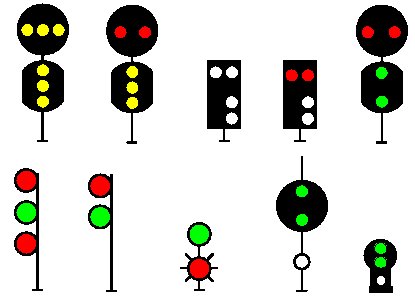
|
Medium Clear
|
Proceed at Medium Speed until entire train clears all interlocking or spring switches, then proceed at Normal Speed.
In CSS territory with fixed automatic block signals, trains not equipped with operative cab signals must approach the next signal at Medium Speed.
|
|
283a
|

|
Medium Approach Medium
|
Proceed at Medium Speed until entire train clears all interlocking or spring switches, then approach the next signal at Medium Speed.
Trains exceeding Medium Speed must begin reduction to Medium Speed as soon as the Medium Approach Medium signal is clearly visible.
|
|
284
|
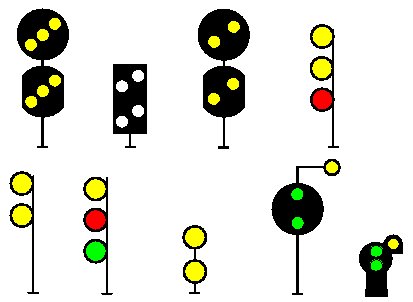
|
Approach Slow
|
Proceed approaching the next signal at Slow Speed. Trains exceeding Medium Speed must begin reduction to Medium Speed as soon as engine passes the Approach Slow signal.
|
|
285
|

|
Approach
|
Proceed prepared to stop at the next signal. Trains exceeding Medium Speed must begin reduction to Medium Speed as soon as the engine passes the Approach signal.
|
|
286
|
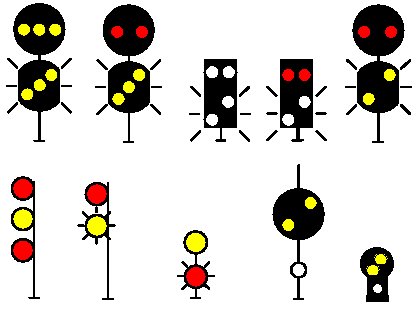
|
Medium Approach
|
Proceed prepared to stop at the next signal. Trains exceeding Medium Speed must begin reduction to Medium Speed as soon as the Medium Approach Signal is clearly visible.
|
|
287
|
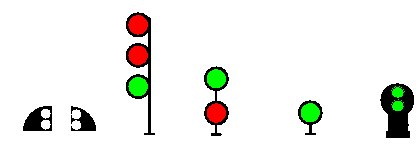
|
Slow Clear
|
Proceed at Slow Speed until entire train clears all interlocking or spring switches, then proceed at Normal Speed.
In CSS territory with fixed signals, trains not equipped with operative cab signals must approach the next signal at Medium Speed once they have left interlocking limits.
|
|
288
|
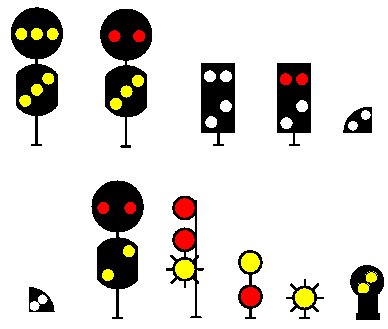
|
Slow Approach
|
Proceed prepared to stop at the next signal. Slow Speed applies until entire train clears all interlocking or spring switches, then Medium Speed applies.
|
|
290
|
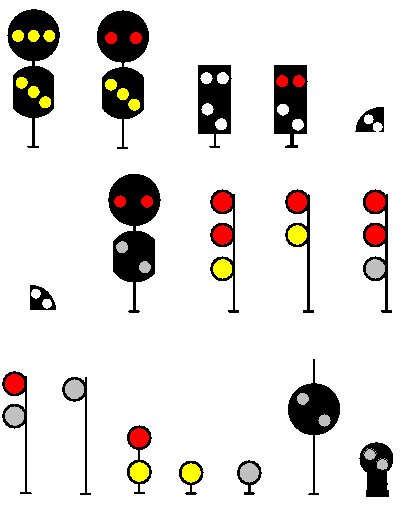
|
Restricting
|
Proceed at Restricted Speed until the entire train has cleared all interlocking and spring switches (if signal is an interlocking or CP Signal) and the leading wheels have:
- Passed a more favorable fixed signal, or
- Entered nonsignalled DCS territory, or
In CSS territory, trains with operative cab signals must not increase speed until the train has run one train length or 500 feet (whichever distance is greater), past a location where a more favorable cab signal was received.
|
|
291
|
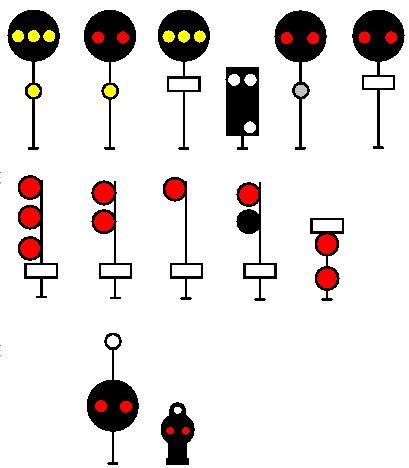
|
Stop and Proceed
|
Stop, then proceed at Restricted Speed until the entire train has cleared all interlocking and spring switches (if signal is an interlocking or CP signal) and the leading wheels have:
- Passed a more favorable fixed signal, or
- Entered nonsignalled DCS territory, or
In CSS territory, trains with operative cab signals must not increase their speed until they have run one train length or 500 feet (whichever distance is greater) past a location where a more favorable cab signal was received.
Where a letter G (grade marker) or a letter R (restricting marker) is displayed in addition to a number plate as part of these aspects, freight trains may observe the signal as though Restricting, Rule 290, were displayed.
|
|
292
|

|
Stop Signal
|
Stop.
|
|
293
|
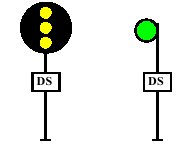
|
Switch Closed Signal
|
Proceed.
|
|
293a
|
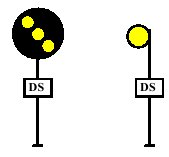
|
Switch Open Signal
|
Proceed prepared to stop short of open switches.
|
|
293b
|

|
Approach Clear
|
Proceed.
NOTE: Does not convey block or track information.
|
|
293c
|

|
Approach Restricting
|
Proceed prepared to stop at the next signal. Trains exceeding Medium Speed must begin reduction to Medium Speed as soon as the engine passes the Approach Restricting signal.
NOTE: Does not convey block or track information.
|
|
294
|

|
Clear Slide Detector Signal
|
Proceed; slide detector not actuated.
|
|
294a
|

|
Slide Detector Signal
|
Approach actuated slide detector prepared to stop short of obstruction.
|
|
296
|
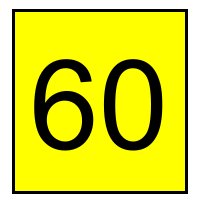
|
Approach Permanent Speed Limit Sign
|
Proceed prepared to operate at posted speed through permanent speed restriction.
NOTE: In electrified territory, this sign will be mounted in the catenary system; in non-electrified territory, this sign will be mounted on an overhead bridge of pole approximately 12 feet above the top of the rail.
|
|
296a
|
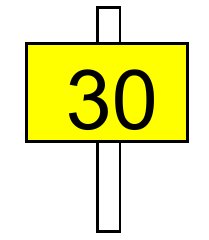
|
Approach Speed Limit Sign
|
Approach the Speed Limit Sign at a speed not exceeding the speed posted on the Approach Speed Limit Sign. Where a sign with two sets of numerals is posted, the higher speed applies to passenger trains, and the lower speed applies to freight trains.
|
|
296b
|
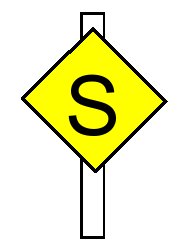
|
Speed Limit Sign
|
Proceed at speed posted on the Approach Speed Limit Sign until the entire train has cleared the Resume Speed Sign.
|
|
296c
|
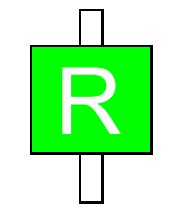
|
Resume Speed Sign
|
Resume speed after the entire train has passed the Resume Speed Sign.
|
|
296d
|
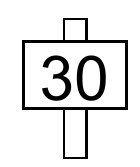
|
Diverging Approach Speed Limit Sign
|
If routed to affected track, approach the Speed Limit Sign not exceeding the speed on the Diverging Approach Speed Limit Sign.
|
|
297
|

|
Approach Sign
|
Proceed prepared to stop at the Stop Sign. Trains exceeding Medium Speed must begin reduction to Medium Speed as soon as the engine passes the Approach Sign.
|
|
297a
|
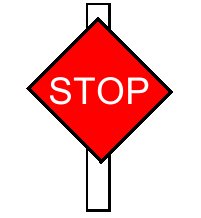
|
Stop Sign
|
Stop, unless permission is received as prescribed by Rule 135.
|
|
297bb
|
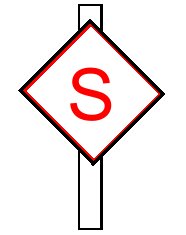
|
Working Limits Speed Limit Sign
|
Proceed not exceeding 30 MPH until passing a Working Limits Resume Speed Sign, unless otherwise instructed by the employee in charge.
|
|
297c
|
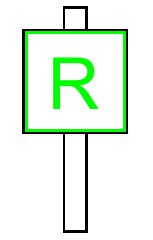
|
Working Limits Resume Speed Sign
|
Resume speed after the entire train has passed the Working Limits Resume Speed Sign.
|
|
297d
|

|
Diverging Approach Sign
|
If routed to affected track, proceed prepared to stop at the Stop Sign. Trains exceeding Medium Speed must begin reduction to Medium Speed as soon as the engine passes the Diverging Approach Sign.
|
|
298
|

|
Distant Signal Marker
|
Visual reminder to push-pull trains that Rule 504(b) applies in the block governed by this signal.
NOTE: Located on or near the mast of distant signals in territory where push-pull trains operate, cab signals are not in service, and the maximum speed of trains exceeds 30 MPH.
|
|
298a
|

|
Delayed In Block Sign
|
Visual reminder to push-pull trains that Rule 504(b) applies to station stops made at this station.
NOTE: Located at or near the end of passenger stations in blocks between distant signals and home signals in territory where push-pull trains operate, cab signals are not in service, and the maximum speed of trains exceeds 30 MPH.
|



































